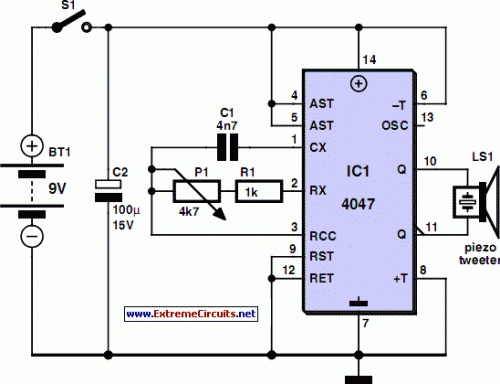FREE
circuits!
How to build Environmentally-friendly Mosquito Repeller
September 27, 2010 - category: Animal repellentDescription
With the return of the fine weather, you’ll doubtless be enjoying lazing around of an evening on your patio or in your garden, but even if you’re not surrounded by marshes or other shallow water it’s very likely some intruding mosquitoes will come along to spoil this idyllic scene. Although indoors it’s easy to get rid of them these days, indeed even to prevent them coming into the house, the same can’t be said for the great outdoors. We might mention the well-known Chinese coils – the only thing Chinese about them is undoubtedly their name – which very often drive people away as much as mosquitoes, if not more! Moreover they are nasty things to handle.
There are also UV (ultra-violet) ‘electrocutors’ consisting of a blue lamp surrounded by two closely-spaced grilles between which a high voltage is applied. The mosquitoes (and fies and other flying insects) are supposedly attracted by the color of the lamp and as they approach, get electrocuted in contact with the two grilles. The only thing you have to do is pull out the drawer from time to time and get rid of the mass of dead insects. Even though the effectiveness of these first two products remains questionable, it is less so than the one we’re nonetheless going to describe here.
We’re talking about an ultrasonic mosquito repellent. The principle, as described by its numerous promoters, is as follows. Only the female mosquitoes bite (that at least is an undisputed scientific fact) and they bite when they need to feed, and above all, to feed their eggs. In this situation, they seek to avoid the males whose ‘job’ has already been done, and so they fy away from the frequencies emitted by the males when they are on heat. This is where opinions now diverge.
Circuit diagram:
According to certain publications, the frequency emitted by the male mosquitoes is said to be around 20–25 kHz, and so within the realm of ultrasound. But according to others, it is in the region of 5–7 kHz instead; frequencies that a human ear, even an elderly one, can still hear very well. Rather than spending lots of money (of the order of tens of pounds) buying such a device, which moreover generally have a fixed frequency, we’re suggesting building one yourself so that you can carry out your own research this summer, especially since the circuit proposed is very simple and cheap to build.
As the figure shows, it uses just a single IC, a CMOS type 4047. This very multi-purpose IC can be wired in very many operating modes, including that of the multivibrator or astable used here. The operating frequency is set by the external components C1, R1, and P1; the latter makes it possible to slightly adjust the frequency, given the uncertainty that exists over the most efective value…To best reproduce the high frequencies produced by the generator, the output transducer used is a simple tweeter, but it must be a piezo one. Such a tweeter behaves in fact much like a capacitor, and so doesn’t overload the CMOS IC outputs that are incapable of supplying a substantial current, as everyone knows who’s ever worked with 400 series CMOS logic.
To obtain an output signal of sufficient amplitude while being powered from a single 9 V battery, this tweeter is connected between the 4047’s Q and Q outputs, making it possible to apply complementary (antiphase) signals to the tweeter so it ‘sees’ an alternating voltage of double the supply voltage. In purely theoretical terms, this quadruples the output power available. In practice, it’s better to regard it as tripling it, but the beneft achieved by doing it this way is nonetheless very real. All that remains is for you to place the project in the middle of the patio table or beside your lounger in order to get a taste of the calm of a summer’s evening without mosquitoes bothering you acoustically or worse, biting. At any rate, that’s what we wish for you…
author: B. Broussas, Elektor Electronics 2008
circuit from http://www.extremecircuits.net/2010/05/environmentally-friendly-mosquito.html


 This category
This category